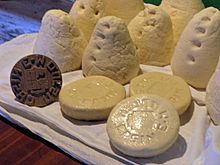Casín cheese facts for kids
Quick facts for kids Casín cheese |
|
|---|---|
 |
|
| Country of origin | Spain |
| Region | Asturias |
| Source of milk | Cows |
| Texture | Semi-hard |
| Dimensions | 10-20 cm × 4-7 cm |
| Weight | 250-1000 g. |
Casín cheese (Spanish: queso Casin) is a special type of cheese from Spain. It's made in a region called Asturias, which is in the northern part of Spain. This cheese has a special name that is protected, meaning only cheese made in a certain way and place can be called "Casín cheese."
It's made from fresh, whole cow's milk. The milk comes from specific types of cows, like the Asturian Mountain (also called Casina), Asturian Valley, and Friesian cows, or mixes of these breeds. The cheese gets its name from the Casina cow breed, which is named after the town of Caso in Asturias.
Casín cheese is made in the southern part of Asturias. This area includes the Redes Natural Park and nearby towns like Caso, Sobrescobio, and Piloña. The cheese can be hard or semi-hard, and it can be aged for different amounts of time.
This cheese usually looks like a thick, round disc. It can be about 10 to 20 centimeters (4 to 8 inches) wide and 4 to 7 centimeters (1.5 to 3 inches) tall. Each cheese weighs between 250 and 1000 grams (about 0.5 to 2 pounds).
Contents
How Casín Cheese is Made
Making Casín cheese is a careful process.
- First, the milk must come from cows that eat natural food from the local area. These milk suppliers must be approved.
- The milk is warmed to about 30 to 35 degrees Celsius (86 to 95 degrees Fahrenheit).
- Then, special ingredients are added to make the milk thicken and form a soft mass called "curd." This takes about 45 minutes.
- The curd is then cut into small pieces, like hazelnut-sized grains. It's stirred and heated a little more.
- After resting, the broken curd is put into special bags or containers with small holes. This allows the extra liquid, called "whey," to drain out.
- The cheese is then placed in cool, airy rooms (about 15 to 20 degrees Celsius or 59 to 68 degrees Fahrenheit) for at least three days. During this time, the cheese is turned over every day.
- Next, the cheese is shaped into its unique disc form, either by hand or with machines. A little salt is added.
- The cheese rests again in ventilated rooms for 5 days to 2 weeks, being turned daily.
- Finally, the cheeses are pressed one more time to make them look nice. Decorations, like flowers or geometric shapes, and the maker's mark are added to the outside.
- They stay in the ventilated room for two more days.
- The cheese then goes into a cooler room (about 8 to 10 degrees Celsius or 46 to 50 degrees Fahrenheit) with some humidity to finish aging. It takes at least two months from when the milk first thickens until the cheese is ready.
Before being sold, Casín cheese is wrapped. This protects its surface because the whole cheese is meant to be eaten. It can be wrapped in paper, cardboard, wood, or food-safe plastic.
What Casín Cheese Tastes Like
Casín cheese has a strong, rich dairy flavor. If the cheese is well-aged, it can taste a bit spicy or peppery. Younger cheese is less peppery. The flavor stays in your mouth for a long time after you eat it.
How Casín Cheese Feels
The texture of Casín cheese is firm but also a bit crumbly. It can also feel slightly rubbery and smooth all the way through. It usually doesn't have big holes inside, but you might see tiny cracks in the cheese.
The Outside of Casín Cheese
Casín cheese has a smooth, thin outer layer called a "rind." The rind is a creamy yellow color, sometimes with white spots. It should be clean and dry, but it might feel a little bit oily. On the surface of the rind, you'll often see pretty designs like flowers, plants, or geometric patterns. The symbol or name of the cheese maker is also usually pressed onto the rind.
See also
 In Spanish: Queso Casín para niños
In Spanish: Queso Casín para niños

